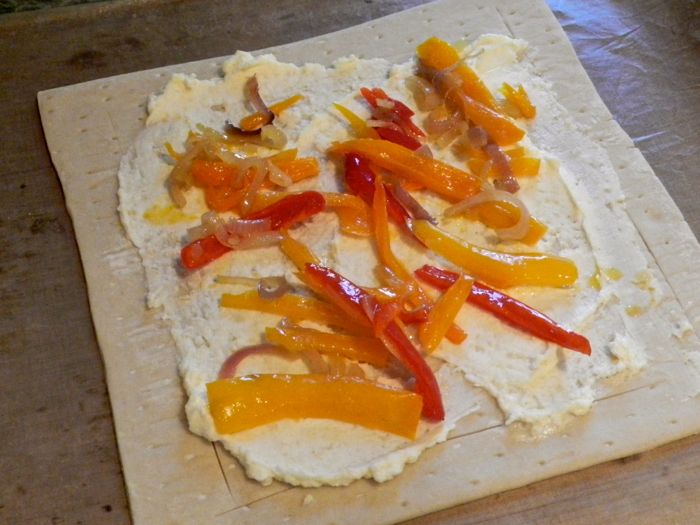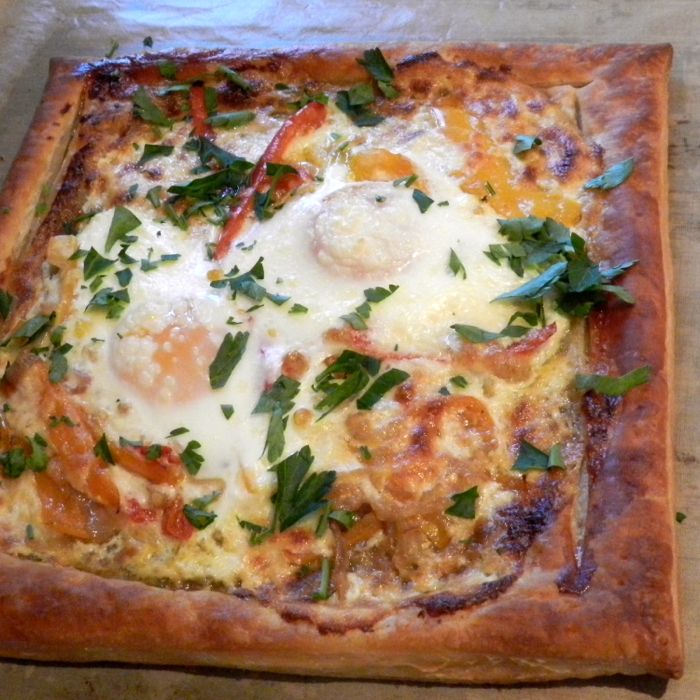Years ago, I was a chef at a health spa, where the focus was on reducing calories and fats, and increasing vegetables and whole grains. It was a sensible plan back then, and remains so today. Thirty years later, I continue to center my meals around vegetables, use locally-sourced meats, and steer away from processed foods. But, unlike the strict diet that I cooked at the spa, I do indulge. I’m not the sort to buy a bag of powdered mini-donuts; I bring home puff pastry and mascarpone cheese. I adore mascarpone cheese, which is a creamy, soured, soft product. It’s similar to creme fraiche, which is a rich sour cream-like product. Either work here. This recipe is topped with eggs from my hens. This is an indulgence worth eating!
Sweet Bell Pepper Tarts with Eggs
1 sheet (8 ounces) puff pastry, defrosted
1 or 2 sweet bell peppers, thinly sliced
1 shallot, thinly sliced
1 tablespoon olive oil
kosher salt and freshly ground pepper
1/2 cup mascarpone cheese (or creme fraiche)
2 eggs
1/4 cup grated Parmesan cheese plus extra for dusting
2 tablespoons chopped flat-leaf parsley
1. Sauté the bell peppers and shallots in the olive oil until soft, golden and fragrant. Season with salt and pepper. Set aside.
2. Preheat the oven to 400 degrees F.
3. Use the best quality puff pastry that you can find. Trader Joe’s carries it, but only during the winter holidays.
Look for these ingredients – it shouldn’t have any fat other than butter!
Puff pastry looks fancy and intimidating, but it’s the easiest product to work with! Depending on the brand, you might have to roll it out a bit, but it starts out in the right shape, it just requires flattening a bit. Place the pastry on a baking sheet lined with parchment paper. Using a knife, score a margin 1-inch in, and halfway through the pastry.
4. In small bowl, combine the mascarpone
mascarpone cheese
and Parmesan. Heat this over boiling water until is softens (or do in the microwave, but take care that the cheese doesn’t cook.)
5. Spread half of the cheese mixture onto the puff pastry, keeping it inside of the scored lines. Arrange the sautéed peppers over the cheese.
6. Spoon the remaining cheese over the pastry. Crack two eggs, nestling them opposite each other. Dust with about a tablespoon of Parmesan.
7. Bake for about 18 to 20 minutes until puffed, brown and the egg yolks are just cooked through.
8. Garnish with parsley and serve.
Cut into 8 pieces for an appetizer, or it satisfies two people for dinner.











